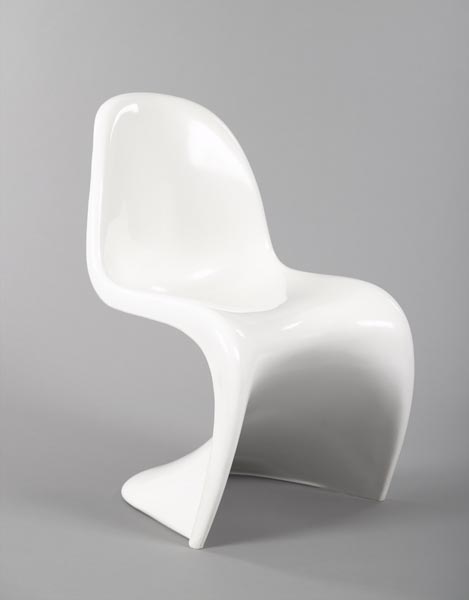This innovative stacking chair is arguably Danish designer Verner Panton’s best known work. While not the first cantilevered chair—Dutch designer Gerrit Rietveld’s 1934 wooden Zig-Zag chair is an earlier example—the Panton chair was the first cantilevered chair made from a single piece of injection-molded plastic. Its fluid organic shape is made to fit the human form.
Panton first studied architecture in the late 1940s. By 1952, he was working for the modernist architect and furniture designer Arne Jacobsen, whose rigorous research into production techniques and materials such as bent wood influenced Panton. He struck out on his own in 1955. Converting a Volkswagon van into a mobile graphics studio, he frequently traveled around Europe, visiting designers and manufacturers and observing developments in international design. Panton returned to Denmark with many unconventional ideas—his style diverged from the characteristic soft, organic Scandinavian modernism and its emphasis on natural materials, particularly wood. Panton was passionate about experimenting with man-made materials, and by the end of the 1950s, his chair designs were very experimental with no discernible legs or backs.
Panton conceived the idea for this chair in about 1960, a time when plastic, a relatively new low-cost petroleum-based material, was increasingly employed by the furniture industry for use in affordable mass-produced goods. It was also a time of cultural shifts: a growing emphasis on youth and a developing Pop culture. Avant-garde designers focused on creating goods for a youthful consumer market that enjoyed a casual lifestyle. The impact of color was seminal, and designers turned to new materials and a palette of primary hues. Lightweight and strong, many plastics could be produced in vibrant colors with glossy surfaces. Panton originally wanted to make this chair in rigid polyurethane foam, but the design did not work in that material. He was ahead of his time. It was not until 1967/68 that plastics production technology caught up with his idea, and the chair could be mass produced in fiberglass-reinforced polyester. Panton’s highly sculptural form is a unified design: rather than being made of assembled parts, the S-curved chair combines seat, back and legs in a continuous molded form. The design eliminates the need for wood or metal supports. The concave base provides stability and takes advantage of the material’s lightness, while allowing the forms to nestle for stacking.
Originally produced in white, blue, black, red, yellow, and green, the chair has become an icon of modern design and is in production today.
Today is Verner Panton’s birthday.
